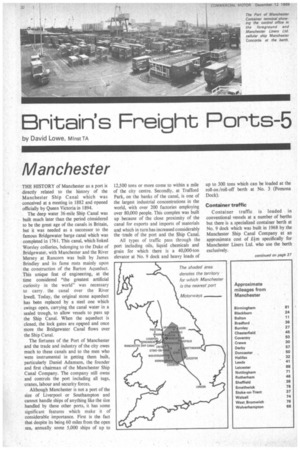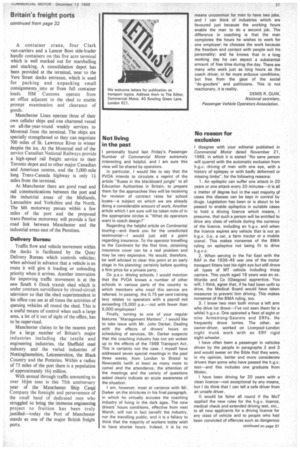Britain's Freight Ports-5
Page 34

Page 75

If you've noticed an error in this article please click here to report it so we can fix it.
by David Lowe, minst TA
Manchester
THE HISTORY of Manchester as a port is directly related to the history of the Manchester Ship Canal which was conceived at a meeting in 1882 and opened officially by Queen Victoria in 1894.
The deep water 36-mile Ship Canal was built much later than the period cOnsidered to be the great age of the canals in Britain, but it was needed as a successor to the famous Bridgewater barge canal which was completed in 1761. This canal, which linked Worsley collieries, belonging to the Duke of Bridgewater, with Manchester and the River Mersey at Runcorn was built by James Brindley and its fame rests mainly upon the construction of the Barton Aqueduct. This unique feat of engineering, at the time considered "the greatest artificial curiosity in the world" was necessary to carry, the canal over the River Irwell. Today, the original stone aqueduct has been replaced by a steel one which swings open, carrying the canal water in a sealed trough, to allow vessels to pass up the Ship Canal. When the aqueduct is closed, the lock gates are opened and once more the Bridgewater Canal flows over the Ship Canal.
The fortunes of the Port of Manchester and the trade and industry of the city owes much to these canals and to the men who were instrumental in getting them built, particularly Daniel Adamson, the founder and first chairman of the Manchester Ship Canal Company. The company still owns and controls the port including all tugs, .cranes, labour and security forces.
Although Manchester is not a port of the size of Liverpool or Southampton and cannot handle ships of anything like the size handled by these other ports, it has some significant features which make it of considerable importance. First is the fact that despite its being 60 miles from the open sea, annually some 5,000 ships of up to 12,500 tons or more come to within a mile of the city centre. Secondly, at Trafford Park, on the banks of the canal, is one of the largest industrial concentrations in the world, with over 200 factories employing over 80,000 people. This complex was built up because of the close proximity of the canal for exports and imports of materials and which in turn has increased considerably the -trade of the port and the Ship Canal.
All types of traffic pass through the port including oils, liquid chemicals and grain for which there is a 40,000-ton elevator at No. 9 dock and heavy loads of up to 300 tons which can be loaded at the roll-on/roll-off berth at No. 3 (Pomona Dock).
Container traffic Container traffic is loaded in conventional vessels at a number of berths but there is a specialized container berth at No. 9 dock which was built in 1968 by the Manchester Ship Canal Company at an approximate cost of Lim specifically for Manchester Liners Ltd. who use the berth exclusively. A container crane, four Clark van-carriers and a Lancer Boss side-loader handle containers on this five acre terminal which is well marked out for marshalling and stacking. A consolidation depot has been provided at the terminal, near to the Vere Street docks entrance, which is used for packing and unpacking small consignments into or from full container loads. HM Customs operate from an office adjacent to the shed to enable prompt examination and clearance of Roods.
Manchester Lines operate three of their own cellular ships and one chartered vessel on all-the-year-round weekly services to Montreal from the terminal. The ships are specially strengthened so they can negotiate 700 miles of St. Lawrence River in winter despite the ice. At the Montreal end of the service Canadian National Railways provide a high-speed rail freight service to their Toronto depot and to other major Canadian and American centres, and the 5,000-mile long Trans-Canada highway is only 1+ miles from the terminal.
At Manchester there are good road and rail communications between the port and the industrial areas of the Midlands. Lancashire and Yorkshire and the North. The M6 motorway passes within a few miles of the port and the proposed trans-Pennine motorway will provide a fast road link between Manchester and the industrial areas east of the Pennines.
Delivery Bureau Traffic flow and vehicle movement within the docks is facilitated by the Quay Delivery Bureau which controls vehicles; when advised in advance that a vehicle is en route it will give it loading or unloading priority when it arrives. Another innovation for improving traffic movement is at the new South 6 Dock transit shed which is under constant surveillance by closed-circuit television so that the shed superintendent in his office can see at all times the activities of queuing vehicles all round the shed. This is a useful means of control when such a large area, a lot of it out of sight of the office, has to be supervised.
Manchester claims to be the nearest port for a large number of Britain's major industries including the textile and engineering industries, the Sheffield steel industry and the varied industries of Nottinghamshire, Leicestershire, the Black Country and the Potteries. Within a radius of 75 miles of the port there is a population of approximately 16+ million.
With annual through traffic amounting to over 16-1m tons in this 75th anniversary year of the Manchester Ship Canal Company the foresight and perseverence of the small band of dedicated men who struggled to bring the immense engineering project to fruition has been truly justified—today the Port of Manchester stands as one of the major British freight ports.
























































































































































